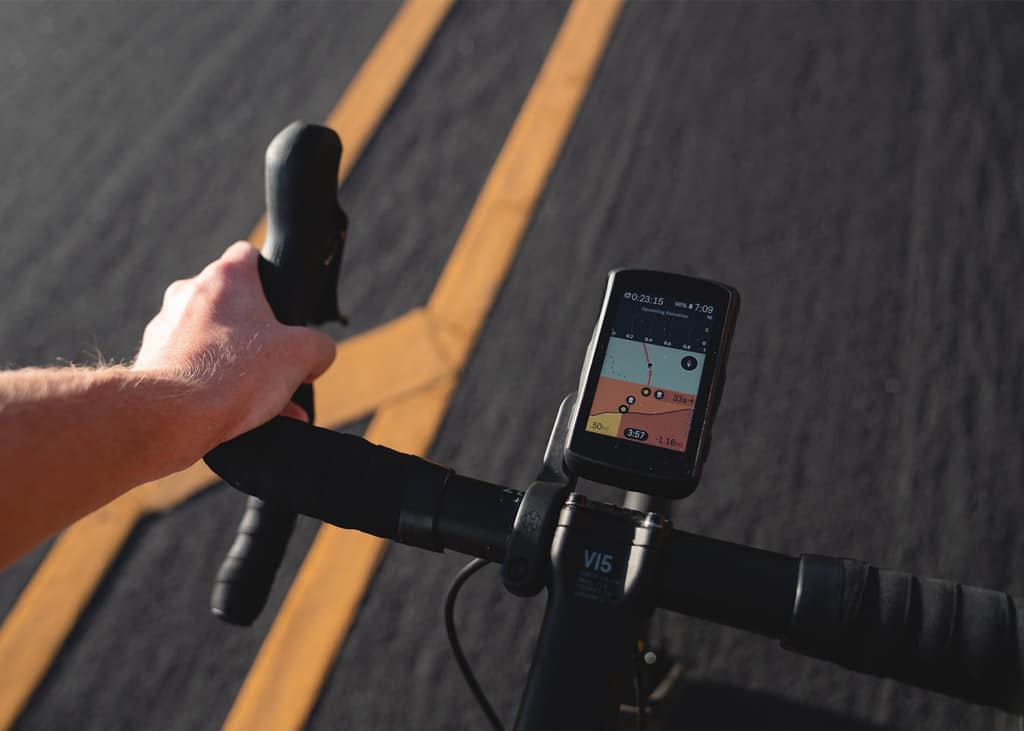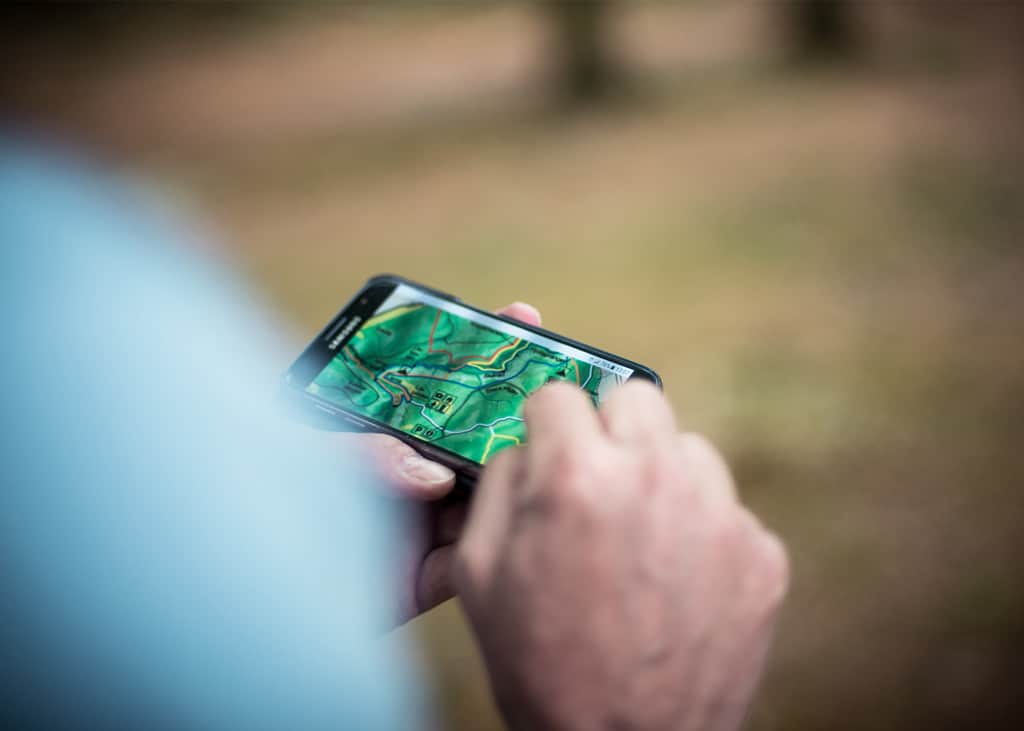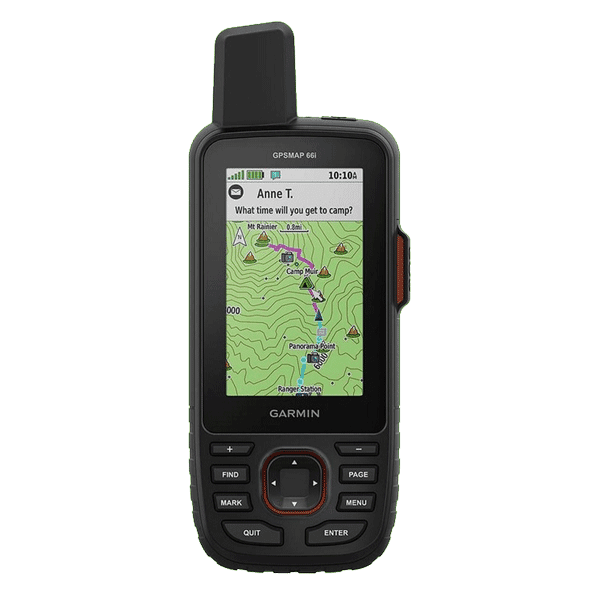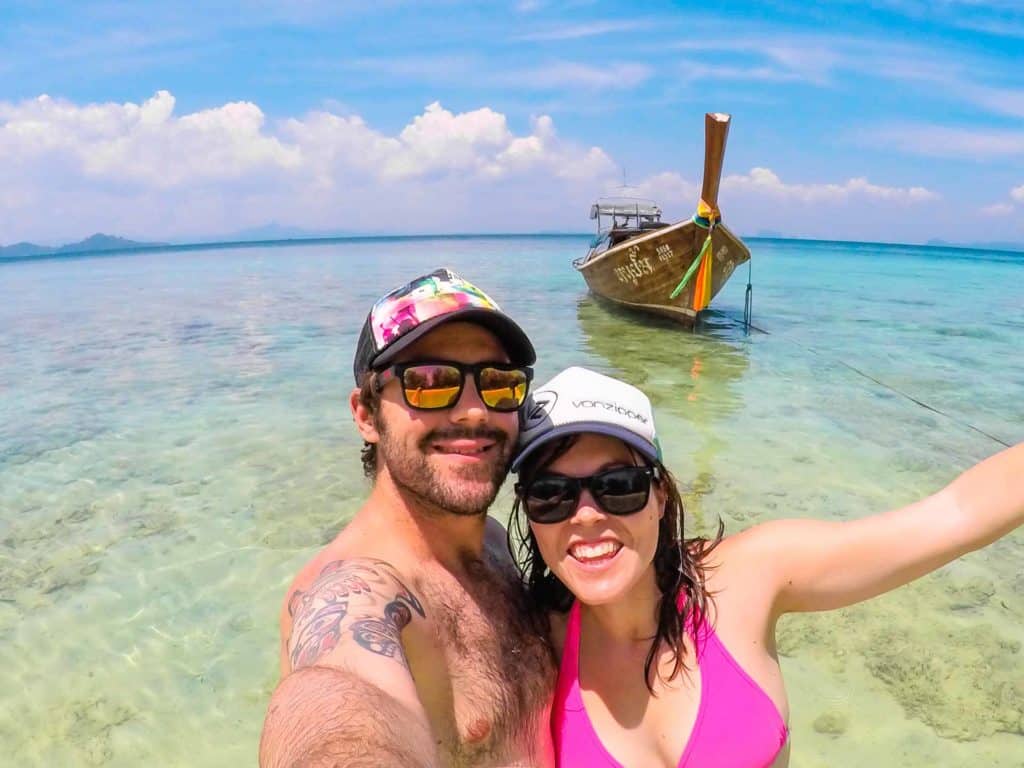Explore more of the great outdoors with the best handheld GPS device of 2025. Find out which GPS unit for hiking is best for your next adventure!
If you do any amount of long-distance, multi-day or backcountry hiking you’ll want to invest in the best handheld GPS device to keep you safe and informed on the trail.
Although there are lots of choices out there, we’ve thoroughly researched and sampled a variety of handheld GPS devices and narrowed your search down to the top 6 handheld GPS devices.
We’re confident that after you read this post, you’ll find the perfect one that meets your wants and needs.
Other Great Options…
- Best Budget Handheld GPS: Garmin Etrex 10
- Biggest Screen: Garmin Montana 700
- Great Overall Value: Garmin GPSmap 64x
6 Best Handheld GPS Devices At A Glance
PRODUCT | PRICE RANGE | DIMENSIONS (cm) | WEIGHT (oz) | SCREEN SIZE (diagonal in) | BATTERY LIFE (hours) | MEMORY (GB) | |
$550 - $650 | 2.6 x 6.4 x 1.4 | 8.1 oz | 3 in | 35 hrs | 16 GB | ||
$250 - $325 | 2.4 x 6.3 x 1.4 | 7.7 oz | 2.6 in | 16 hrs | 8 GB | ||
$350 - $425 | 2.4 x 4.5 x 1.3 | 5 oz | 3 in | 16 hrs | 1.5 GB | ||
$140 - $175 | 2.1 x 4 x 1.3 | 5 oz | 2.2 in | 25 hrs | * 8 MB | ||
$650 - $750 | 3.4 x 7.2 x 1.3 | 14.5 oz | 5 in | 18 hrs | 16 GB | ||
$400 - $500 | 2.7 x 6.5 x 1.5 | 3.1 oz | 2 in | 100 hrs | 12 GB |
The Best Handheld GPS – Our Expert Guide
From high-tech devices that can take pictures and communicate with home to simple handhelds that keep you on track, let’s take a look at the industry-leading handheld GPS that helps you do more in the great outdoors.
NOMADasaurus Pick: Garmin 66i
Sitting at the top of the class is this professional life-saver. The handheld GPS device fits nicely in your palm in a way that lets you access all the buttons one-handed.
An incredibly fast wireless connectivity process helps you get your message across when there aren’t many seconds to wait, and a preloaded text system speeds up the process even further.
The bright screen is easily readable, even in direct sunlight, and an optional expedition mode helps stretch out the battery life for up to a week of navigation.
You can program messages or use your smartphone’s keyboard to take advantage of the satellite messaging services to share your waypoints and routes alongside a quick update. A full on-screen keyboard with predictive text is also available.
Something that really sets Garmin apart as some of the best handheld GPS options is the two-way SOS communication. At the push of a button, you can have a conversation with emergency services and get help sorted out stat.
PROS
- A rugged outer shell can handle peaks and valleys
- Powerful signal gets up fast when there are no seconds to waste, also helps track routes through narrow passes and dense vegetation
- The best overall handheld GPS from the best hiking GPS company on the planet
CONS
- One of the newest GPS options on the market, but the screen needs a facelift to look the part
- Most expensive GPS on our list
Garmin GPSmap 64sx
The GPSmap series is Garmin’s most advanced satellite messaging system yet, so it’s no surprise to see its two benefactors at the top of the leaderboards.
The Garmin GPSmap 64sx is a more affordable version of the 66i, packing in the same hyperfast connectivity and worldwide coverage into a more basic body.
It doesn’t have some of the same bells and whistles as our editor’s choice, but these GPS units are just as capable of getting you out of a pickle.
The barebones handheld GPS device doesn’t come with a touch screen, but for an extra hundred bucks, you could add on an 8-megapixel camera and finally leave the phone at home.
A handy d-pad allows you to receive messages and formulate rudimentary responses, but I wouldn’t recommend the handheld GPS devices for writing your next opera.
The Garmin gpsmap system allows access to a wide array of topographic maps, and a partnership with GLONASS satellite systems provides some of the most precise navigation in the market. You can preload your waypoints and navigate tricky terrain with confidence.
In short, this budget version of our editor’s choice takes advantage of the same birdseye satellite imagery as our favorite model to provide a hyperactive GPS unit, but no satellite messaging or SOS communication.
PROS
- Heavy-duty antennae pump out great GPS signals through rough undergrowth
- Wide-ranging mapping software provides preloaded topo maps with no subscription required
- Communication with multiple satellite systems invites GPS signals just about anywhere
CONS
- Lack of many communication skills found on some of our other GPS devices
- Heavier and bulkier than handheld devices like iPhones
Garmin Oregon 700
Navigating the Oregon trail would have been a whole lot easier with this handheld GPS device. Garmin’s compact GPS units keep things simple while still storing a wealth of information for your next trip to the backcountry.
The newest Oregon models include animated weather radar as long as you have a cell phone signal, allowing this handheld GPS unit to suggest the best times to take a risky summit.
Preloaded maps and Garmin’s patented global positioning system will light your path, and an optional 8 MB camera further improves this handheld’s capabilities.
We love how simple these portable GPS capabilities are while still providing modern services and a user-friendly map screen. The entire GPS device can clip onto your hiking backpack or slip in your pocket and uses its upgraded antenna to grab hold of satellite signals fast.
PROS
- Enough internal memory to stow thousands of topo maps
- Cycle between GPS and GLONASS sensors to plot your course
- The camera makes for easy geocaching placement or just snapping photos of the trail
CONS
- Shorter battery life than other similarly priced handheld GPS devices
- Lacking many physical buttons, the touchscreen gps receiver struggles in wet conditions
Garmin Etrex 10
The Garmin Etrex 10 is the best budget handheld GPS device in the business. Thanks to its price point of several hundred dollars less than the other GPS trackers on our list, the Garmin etrex 10 should be a part of every single outdoor expedition.
The minute hiking GPS gets the most out of two AA batteries because of Inreach’s super fast satellite acquisition. The Garmin etrex 10 promises 25 hours of battery life, which is more than enough time to plot a course for a long weekend in the woods.
While this is primarily a backup emergency button, the Garmin etrex 10 still provides an electronic compass and waypoint navigation for geocaching.
Beyond a few basic features and nifty tricks, you won’t find much else than GPS mode in this hiking GPS device. What it does do, it does at an incredibly high level to more than justify the affordable price tag.
PROS
- Everything you need to explore while still saving a few dollars
- Has access to the same additional maps, GPS network and smartphone GPS apps as all the other Garmin devices
- Decent enough to use as a geocaching device
CONS
- Doesn’t provide the same perks as most other Garmin models
- While the battery life is still decent, using AA batteries in this day and age feels a bit crude
Garmin Montana 700
This is one of the beefier options in the handheld GPS market. The Garmin Montana rocks a screen size that has double the diagonal size of most GPS devices to help get the most out of cell signals and GPS satellites.
That makes it a good handheld GPS for anyone who’s doing a fair amount of treasure hunting or just wants a bit more than a digital compass to lead the way.
You won’t find any other GPS models this easy to read, and an intuitive touch screen works really well with the extended screen. It makes maps easier to navigate, and Garmin Montana also comes with plenty of applications built for communication, including Garmin inreach satellite messaging.
The Inreach services also help you navigate country roads and dirt tracks, so it’s perfect for hiking, motorcycling, and mountain biking alike. While all this information does demand a bit of extra weight, this is one of the best hiking GPS options for offroading on two wheels as well as two feet.
PROS
- Large screen and GPS app communication make this one of the most feature-friendly handheld GPS devices
- The best handheld GPS devices for user experience
- A rechargeable lithium-ion battery helps you make the most out of the large display
CONS
- A bigger screen makes for a heavier weight than most GPS units
- Incredibly well suited for navigating the backroads, a bit much for walking only
Garmin Inreach Explorer +
We’ll round out our list with one of the best handheld GPS units that also allows satellite phone communication.
Thanks to hours and hours of battery life and access to the Garmin Inreach explorer network, you can keep this handheld GPS on all weekend and have the confidence to make a call in a hurry.
It’s not the only GPS on our list that can provide two-way communication with emergency services, but it’s become the name most synonymous with the system. It’s the next best thing to a sat phone, as a quick message to your friends, family, and the forest service will all be one click away.
A few buttons and a big red SOS work together to help the handheld GPS send for help, while Garmin’s immense satellite system and wide area augmentation system can access loads of waypoints and really open up the outdoors.
All this freedom, easily usable with one hand, makes this one of the best handheld GPS devices for organizing meet-ups and ride-along in the backcountry.
PROS
- One of the best hiking GPS devices for two-way messaging
- An electronic compass and barometric altimeter round out a quality feature list
- Packs in 30 days of battery life in power save mode
CONS
- Most of the best perks of this device are locked behind a subscription service
- The texting keyboard is difficult to use for anything more than simple messages
You may also be interested in…
- Best Headlamp
- Best Hiking Boots
- Best Hiking Socks
- Best Hiking Backpack
Choosing the Best Handheld GPS
Getting lost in the woods is best done with a bit of backup. If your paths routinely take you off the trail and out of cell service, it’s high past time to slip a global positioning system into your back pocket.
Handheld GPS devices pack in the battery life and features to do everything from getting you home safe to helping you discover new corners of our big backyard. There is one brand that dominates the current market: Garmin.
Garmin has dominated the top of the charts thanks to its partnership with multiple satellite networks, including the Iridium GPS and Glonass. Their unparalleled coverage, plus their substantial feature set, make them an absolute no-brainer. Today, we’ll explore why.
As you may have noticed from our list, GPS technology has come a long way in recent years. Every one of these devices has capabilities far beyond those of your smartphone, and some take things a step further by adding special features that make them even more versatile.
Now that you’ve seen the industry’s best, we’ll break down each feature that we used to judge our favorite handheld GPS.
These factors will have different levels of importance depending on what exactly you want out of your handheld GPS, so read along to find out more about what makes a GPS great.
Screen Size and Readability
There’s no point in carrying around the dang thing if you can’t read it! GPS’ should give you every bit of information you need to know at a quick glance, so you don’t have to spend the entire hike staring at your palm.
The Garmin Montana 700 is the largest screen on our list. If you’re shopping for a handheld GPS for offroading in a motorized vehicle or bicycle, we highly recommend splurging for the extra view.
The difference in a second isn’t much while walking, but while zipping through the treeline and bombing hills, a second makes all the difference.
Besides the Garmin Montana, every other GPS on our list will provide a relatively similar value in this category. Thru-hikers or anyone who needs their GPS to make the most out of its battery life are better off with a smaller screen, as it will be lighter and more efficient.
Garmin has also made a concentrated effort in recent years to provide anti-glare screens that still read well when the sun is at its zenith.
The Garmin Etrex and Garmin Oregon series are lagging behind in this regard, but the other handhelds on our list are incredibly readable no matter the sunlight.

Reception and Speed
If it’s got the Garmin name front and center, your GPS promises to be accurate to within 3 meters. That means any one of these handheld units provides more than enough accuracy to track down geocaches and trailheads.
To take things a step further, you should look for GPS units that connect to multiple satellite systems.
Any navigator in Garmin’s gpsmaps series has a connection to Global Navigation Satellite Systems (GNSS), which means you’ll have access to every satellite company currently in the sky. Look for the label “multi-GNSS support” to confirm your freedom to ram.
This is essential for adventurers planning on heading under heavy cover or into canyons where some weaker signals may not penetrate. Skyscrapers and trees can slow things down a notch, but the multi-GNSS ability will also provide the fastest GPS connection.
Hopefully, you’ll never have to make the most out of your handheld GPS, but when the time comes to press the big red button, I want nothing less than an ironclad guarantee that help will be on the way, fast.
Dimensions and Weight
This category is heavily related to screen size, and the same rules apply. Anyone shopping for a handheld GPS that works while on wheels should opt for larger dimensions at the cost of a few ounces.
For day trips and geocachers, the dimensions and weight of your handheld GPS shouldn’t matter as much to you as ease-of-use features like waypoints and media storage.
Anyone planning on spending a few weeks getting to know their GPS should keep the dimensions and weight to a minimum.
Battery Life
The main reason to opt for fewer dimensions and lighter weight is battery life. This is one particular device where battery life should be of utmost importance. The longer you’re out in the woods, the more important your GPS can become.
Day three into a 6-day mission is a horrible time for your battery to crap out on you, so splurging for more battery is absolutely worth it if you’ve got some serious plans ahead.
The good news is, every single one of the GPS units on our list will get you through a day in the woods, and most of our models have various modes that can provide hundreds of hours of mapping.
If you shop from our list, your GPS will either use AA batteries or rechargeable battery packs. We prefer lithium, as you can get a better idea of how much battery is left in the device and easily charge it in the car along the way to the trailhead.
A portable solar panel is also more than capable of bringing life back to your unit, whereas if you forget to pack spare AAs, you are shit out of luck.
Battery life is also a good reminder that no matter how great technology becomes, nothing can beat a good old-fashioned compass and map. If you’re going anywhere where GPS could be a lifesaver, bring along these two tools, just in case.
Special Features
Any one of the GPS units on our list will provide accurate location services and give you a map in your hand. That is good enough for a lot of adventures, and if it’s good enough for you, you can save a few hundred bucks while you’re at it with the Garmin Etrex line.
If you’re looking for a bit more out of your GPS, here’s a bit about each special feature you’ll find in some of the higher-end Garmin models.
Waypoints
Waypoints are positions that you can store on your GPS before you leave the house to help you navigate, a lot like checkpoints.
Even some of the most audacious expeditions won’t hit the 500 waypoint limit of our smallest device, the Garmin inreach+, but if you’re someone who wants to hold on to years of waypoints or has an extreme use case, splurge for up to 10000 memory points on our editor’s choice model.

Barometric Altimeter
This is an essential feature for anyone who wants their GPS to help them summit. An altimeter will keep track of your distance above sea level while a barometer tracks pressure in the air.
Together, a barometric altimeter can give a decent estimation of good times to summit and help predict weather patterns.
Luckily, every GPS on our list includes at least a basic barometric altimeter system.
Compass
While no piece of technology should ever replace a compass that can run without batteries in your kit, every GPS in our guide will also help you always point north.
Media Storage
The GPS on our list stores anywhere from 60 Millibytes to 16 Gigabytes. More space on your GPS means more maps and also allows room for more details.
More storage opens up space for improved waypoints and even satellite images of the terrain ahead.
Satellite Messaging
While getting into the backcountry is all about getting away from it all, it’s always a good idea to pack something that can call for help outside of cell service.
Anyone shopping for a GPS that is taking them through multi-day adventures should spring for a handheld device that can communicate, even crudely, on a satellite signal.
Hopefully, you’ll never usSatellitete messaging for anything more than checking in with the family every few days, but if the time ever comes when you do neeSatellitete messaging, having a communicator is priceless.
We would never dream of spending a few days in the woods without this essential lifeline in my pocket.
Geocaching
Every handheld GPS on our list is ready for a geocaching adventure. Even the most affordable Garmin etrex 10 allows you to upload locations of stash spots in the woods and parks near you and makes for a great entry-level GPS for exploring a whole world of hidden treasure.
Handheld Vs. Mobile App
While there are several GPS apps that are starting to bridge the gap between handhelds, you still shouldn’t consider your phone as a worthwhile replacement if you plan on heading far away from the nearest cell tower.
Mobile apps can use GPS satellites only, while most of the handheld GPS on our list take advantage of a wider array of satellite systems.
Many casual hikes may get by just fine without needing Iridium’s help, but the extra coverage is the greatest advantage handhelds can still hold onto.
Conclusion
There comes a time in every explorer’s journey when a smartphone just won’t cut it. These handheld GPS units are hooked up to the strongest satellite systems available and come chock full of features that will take full advantage of their support.
None does it better than our editor’s choice Garmin Gpsmap 66i, which comes with every special feature in the book with intuitive buttons and large screen size to help clear up the densest woods.
NOMADasaurus Pick
Garmin GPS Map 66i
The 66I is the culmination of Garmin’s global positioning dominance. If you’re willing to pay top dollar for your system, this beauty has every single feature you could expect out of a GPS, and then some.
With an additional subscription, you can access messaging services far out of range of your cell phone, and the 66i has the best hardware backing up Garmin’s GPSmap system, which has proven to provide the widest-ranging satellite support in the business.
And, of course, it’s all protected by a rugged weatherproof shell.
You may also be interested in…
- Best Headlamp
- Best Hiking Boots
- Best Hiking Socks
- Best Hiking Backpack
DISCLAIMER: Some of the links in this article are affiliate links, which means if you book accommodation, tours or buy a product, we will receive a small commission at no extra cost to you. These commissions help us keep creating more free travel content to help people plan their holidays and adventures. We only recommend the best accommodations, tours and products that ourselves or our fantastic editorial team have personally experienced, and regularly review these. Thanks for your support, kind friend!










1 thought on “The Best Handheld GPS Device Of 2025 | Top 6 Portable GPS Units”
Great review! I’ve been in the market for a new handheld GPS device and this helped me narrow it down to the top contenders. The features and comparisons were really helpful. I’m still unsure between the Garmin eTrex 32x and the Magellan TRX7 CS. Can anyone who has used either of these models recommend which one would be a better choice for backyard hunting and camping?